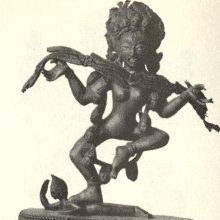Vajradakini, Vajraḍākinī, Vajra-dakini: 2 definitions
Introduction:
Vajradakini means something in Buddhism, Pali. If you want to know the exact meaning, history, etymology or English translation of this term then check out the descriptions on this page. Add your comment or reference to a book if you want to contribute to this summary article.
Images (photo gallery)
In Buddhism
Tibetan Buddhism (Vajrayana or tantric Buddhism)
Source: archive.org: The Indian Buddhist Iconography1) Vajraḍākinī (वज्रडाकिनी) refers to one of the six Goddesses standing on the six spokes of the wheel of the sun, according to the Saptākṣara-sādhana.—Accordingly, [...] on each of the six spokes of the wheel of the sun on which the god stands there are six deities, namely, (commencing from the right) Herukī, Vajravārāhī, Ghoracaṇḍī, Vajrabhāskarī, Vajraraudrī and Vajraḍākinī. They have respectively blue, yellow, red, green, smoky and white colour. All of them have dishevelled hair, fierce appearance, three eyes and the quarters as garments. They carry the resounding ḍamaru and the ghaṇṭā in the first pair of hands, and the human skin in the other pair. They [viz., Vajraḍākinī] stand on the orb of the sun placed on a corpse. Their head-dresses are decorated with rows of skulls, and they stand in the ālīḍha attitude
2) Vajraḍākinī (वज्रडाकिनी) refers to one of the four deities situated in the four petals in the four cardinal directions of the mahāmāyāmaṇḍala, according to in the 5th-century Sādhanamālā (a collection of sādhana texts that contain detailed instructions for rituals).—Vajraḍākinī is described in the mahāmāyāmaṇḍala as follows: “[...] the four petals in the four cardinal directions of the lotus seat are occupied by the following goddesses:—(1) Vajraḍākinī in the east, who is blue in colour with four faces of blue, yellow, white and green colour, and carries the khaṭvāṅga and the ghaṇṭā in the two left hands and the vajra and the kapāla in the two right. [...] These four deities [viz., Vajraḍākinī] exhibit wrath, have their heads decorated with a number of skulls, have garlands of heads still wet with blood, three eyes and portruding teeth. Their brown hair stream upwards in the shape of a flame, and flames of fire radiate from their persons”.
Source: academia.edu: A Critical Sanskrit Edition and a Translation of Kambala’s Sādhananidhi, Chapter 8Vajraḍākinī (वज्रडाकिनी) is the name of a deity associated with the syllable “oṃ” of the Quasi-heart Mantra of Heruka (upahṛdayamantra): one of the four major mantras in the Cakrasaṃvara tradition, as taught in the eighth chapter of the 9th-century Herukābhidhāna and its commentary, the Sādhananidhi. The Upahṛdaya-mantra consists of seven letters. [...] The purity of these seven deities [viz., Vajraḍākinī] is the Seven Limbs of Enlightenment (bodhyaṅga).

Tibetan Buddhism includes schools such as Nyingma, Kadampa, Kagyu and Gelug. Their primary canon of literature is divided in two broad categories: The Kangyur, which consists of Buddha’s words, and the Tengyur, which includes commentaries from various sources. Esotericism and tantra techniques (vajrayāna) are collected indepently.
See also (Relevant definitions)
Partial matches: Vajra, Dakini, Takini.
Full-text: Upahridayamantra, Ghoracandi, Vajrabhaskari, Vajraraudri, Heruki, Saptakshara, Mahamayamandala, Vajravarahi.
Relevant text
Search found 2 books and stories containing Vajradakini, Vajraḍākinī, Vajra-dakini, Vajra-ḍākinī; (plurals include: Vajradakinis, Vajraḍākinīs, dakinis, ḍākinīs). You can also click to the full overview containing English textual excerpts. Below are direct links for the most relevant articles:
The gods of northern Buddhism (by Alice Getty)
Blue Annals (deb-ther sngon-po) (by George N. Roerich)
Chapter 2b - Kyungpo Naljor Disciples (Iv): Sangs Rgyas Ston Pa < [Book 9 - Kodrakpa and Niguma]
